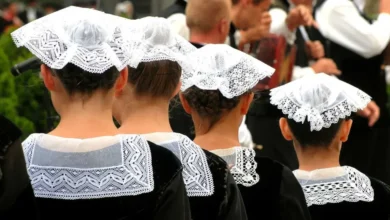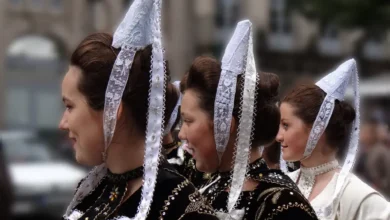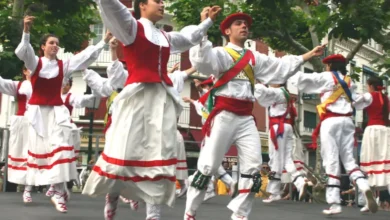France, celebrated globally for its haute couture and artistic heritage, also possesses a remarkable tradition of regional folk attire. From the pastoral regions of Brittany to the sunlit coasts of Provence, French traditional clothing reveals a rich tapestry of history, craftsmanship, and cultural identity. Though modernity has transformed fashion, these traditional garments remain vital in festivals, ceremonies, and cultural expressions.
A Historical Overview of French Traditional Clothing
Medieval Roots and Regional Diversity
The evolution of French folk attire dates back to the Middle Ages when clothing served both functional and symbolic purposes. Peasants wore sturdy garments for daily labor, while wealthier classes displayed their status through intricate embroidery, luxurious fabrics, and elaborate designs. Regional variations emerged due to France’s diverse geography, creating unique styles influenced by climate, resources, and local customs.
Renaissance and Baroque Influence
During the Renaissance and Baroque periods, French fashion flourished. The artistic refinement of these eras influenced folk clothing, integrating vibrant colors, delicate lacework, and elaborate patterns. This blend of practicality and elegance became a hallmark of French traditional attire.
Key Components of French Traditional Attire
Women’s Clothing
- Blouses: Made from linen or cotton, these blouses often feature lace collars, embroidery, or puffed sleeves.
- Corsets and Bodices: Worn over blouses, corsets are decorated with ribbons, lace, or floral motifs, emphasizing the silhouette.
- Skirts and Petticoats: Full-length skirts in bold colors or patterns are paired with layered petticoats for volume.
- Aprons: Embroidered or plain, aprons signify practicality while adding a decorative touch.
- Headdresses: From the elaborate coifs of Brittany to the wide-brimmed hats of Provence, headwear is a distinctive element of regional identity.
Men’s Clothing
- Shirts: Simple yet elegant linen shirts, often adorned with subtle embroidery.
- Vests and Waistcoats: Typically made of wool or silk, waistcoats add a formal layer and showcase vibrant patterns.
- Trousers or Breeches: These are tailored for comfort and durability, often tucked into leather boots.
- Jackets and Cloaks: Woolen jackets or capes provide warmth and style, especially in cooler regions.
- Hats: Wide-brimmed hats, berets, or caps complete the look, reflecting local traditions.
Accessories
French traditional clothing features thoughtfully crafted accessories such as:
See also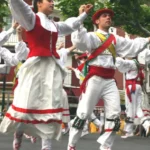 Traditional Clothing in France: Basque Costume
Traditional Clothing in France: Basque Costume- Jewelry: Intricate necklaces, brooches, and bracelets often featuring pearls or precious stones.
- Scarves and Shawls: Worn for warmth and elegance, these are typically embroidered with floral or geometric patterns.
- Footwear: Wooden clogs, leather boots, or delicate slippers, depending on the region.
Regional Variations of French Folk Attire
Brittany
Known for its iconic coifs—intricately designed lace headpieces—Brittany’s traditional clothing is characterized by black dresses with colorful embroidery and white lace accents. Men wear embroidered vests and wide-brimmed hats, reflecting the region’s maritime heritage.
Provence
Provençal attire embraces the sunny climate with lightweight fabrics, vibrant patterns, and straw hats. Women’s dresses often feature floral motifs, while men wear linen shirts and simple trousers.
Alsace
Alsatian traditional clothing is marked by bold contrasts—women wear black velvet bodices paired with bright skirts and oversized silk bows. Men’s attire includes woolen jackets and embroidered waistcoats.
Normandy
Norman folk costumes are practical yet elegant. Women’s dresses incorporate striped fabrics and embroidered aprons, while men wear tailored vests and wide-brimmed hats.
See also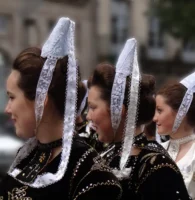 Brittany’s Traditional Coiffes: The Lace Headdresses of Breton Women
Brittany’s Traditional Coiffes: The Lace Headdresses of Breton WomenAuvergne
In Auvergne, known for its rural charm, traditional clothing includes sturdy woolen garments. Women wear layered skirts and lace collars, while men don broad-brimmed hats and leather shoes.
Traditional Clothing in French Celebrations
Festivals and Parades
French festivals offer a vibrant display of traditional attire:
- Fest-noz (Brittany): A celebration of Breton culture featuring folk dances and music, where participants wear traditional costumes.
- Transhumance Festivals: These events in Provence highlight pastoral traditions, with locals dressed in Provençal attire.
- Alsace Wine Festivals: Celebrating the region’s viticulture, participants wear folk costumes while enjoying music and wine.
Weddings and Religious Ceremonies
Traditional clothing remains significant in French weddings, especially in rural regions. Brides often wear lace-adorned dresses, while grooms don formal vests and cloaks, symbolizing cultural pride and unity.
Craftsmanship and Artistry in French Folk Attire
Textile Traditions
French traditional clothing reflects exceptional craftsmanship. Artisans use handwoven fabrics, natural dyes, and intricate embroidery techniques. Regions like Alençon are famous for their lace-making expertise, while Lyon excels in silk production.
Embroidery and Decorative Details
From floral patterns to geometric designs, embroidery is central to French folk attire. Techniques vary by region, ensuring each garment tells a unique story.
Sustainable Practices
Eco-friendly materials such as linen, wool, and cotton are commonly used, emphasizing durability and environmental responsibility.
Preservation and Modern Revival
Cultural Organizations
Institutions like the Musée des Arts et Traditions Populaires play a crucial role in preserving French traditional clothing. They organize exhibitions, workshops, and events to celebrate and maintain this heritage.
Contemporary Influence
Modern French designers often draw inspiration from traditional elements, incorporating lace, embroidery, and regional motifs into haute couture. This fusion keeps the legacy alive while appealing to contemporary tastes.
Experiencing French Traditional Clothing Today
Museums and Exhibits
- Musée des Traditions Bretonnes (Brittany): Showcases Breton folk costumes and lacework.
- Musée Provençal du Costume et du Bijou (Provence): Highlights Provençal attire and accessories.
Festivals and Markets
- Carnival of Nice: Features colorful costumes influenced by traditional and modern styles.
- Christmas Markets: A great place to find handmade accessories and regional clothing.
Artisan Workshops
Across France, workshops offer insights into the artistry behind traditional garments, allowing visitors to appreciate the skill and dedication of local craftspeople.
A Tapestry of Elegance and Heritage
French traditional clothing is a living expression of the country’s history, artistry, and cultural diversity. Whether showcased during festivals, preserved in museums, or reimagined in modern fashion, these garments celebrate France’s enduring legacy and regional charm.

